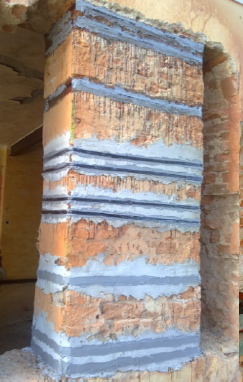1 Building and Civil Engineering Institute ZRMK Ljubljana, Dimičeva 12, Slovenia, mojca.jarc-simonic@gi-zrmk.si
2 PhD, Building and Civil Engineering Institute ZRMK Ljubljana, Dimičeva 12, Slovenia, samo.gostic@gi-zrmk.si
3 PhD, Professor, University of Ljubljana, Faculty of Civil Engineering and Geodesy, Jamova 2, Slovenia, roko.zarnic@fgg.uni-lj.si
ABSTRACT
One of the most promising methods of strengthening of masonry walls against in-plane load that usually appears in earthquake is application of reinforced polymers (FRP) to the surface of the wall. Within the framework of European FP7 research project PERPETUATE (focused on development of new computation models for masonry and strengthening techniques) new innovative configurations of fibre reinforcement placement on clay brick masonry were developed. Six specimens (width / height / thickness = 100 / 210 / 52 cm) of walls, made of solid bricks in low strength lime-cement mortar, positioned in approximately 100 years old building, were in-situ tested by displacement controlled horizontal cyclic load. Innovativeness of the first presented reinforcement is in efficiency of very narrow horizontally placed CFRP strips, providing the confinement effect to masonry brick rows and of the second the use of less fragile mortar for placing GFRP mesh over entire surface. Two specimen of each were compared to two unreinforced ones. The biggest gain of narrow horizontal strips was in ultimate displacement, ductility and dissipated energy, but also in low costs, easy mounting and low interference with the buildings (appreciated in historic monuments). Both types of reinforcement significantly increase the shear resistance. The horizontal confined strips also successfully overcome the problem of FRP detaching from masonry wall, the main problem of FRP-masonry common behaviour.
KEYWORDS: masonry, FRP, strengthening, in-situ test, shear strength, ductility
185.pdf



